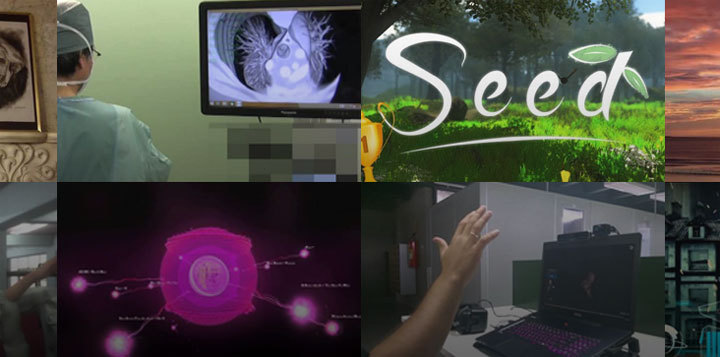Intel RealSense App Challenge - Winners Parade

The next competition of applications using Intel RealSense technology - Intel RealSense App Challenge 2014 has ended , its winners are announced. Let’s, without further ado, on a good Friday habitation, just look at the best programs created as part of the competition. Indeed, there is something to see and something to be impressed with. Another little step taken tomorrow. We will testify to the success and let's move on - to new achievements and a new competition, which will certainly take place.
First, we recall that in the competition there were 2 tracks: Ambassador and Pioneer. Permanent community members who participated in the last contest were invited to the Ambassador track; Pioneer track was open to everyone. Applications were divided into 5 categories:
- Gaming and Play (Fun & Games)
- Immersive Collaboration / Creation
- Learning and Edutainment (Education and Learning through Entertainment)
- Interact Naturally
- Open Innovation
Well, now directly the parade of the winners of the competition in the overall classification and by category.
Ambassador Grand Prix (and Contest Winner) - Seed
Alexandre Ribeiro da Silva, Brazil
Application Category - Gaming and Play.
The player controls a tiny seed that fell from a tree and must spawn a new one, having previously gone through a series of trials of various natural disasters. The seed is controlled, naturally, using gestures.
The toy, obviously, is designed for the smallest, its scenario is simple and straightforward. However, her example shows where to move in order to make really exciting games with interesting gameplay. And the graphics - yes, the graphics are on top. Still, professionals worked.
Pioneer Grand Prix - Orthosense
David Schnare, Canada
The application category is Open Innovation.
A medical application that allows you to track the movements of the hand and fingers of a person to identify real and potential problems with bones and joints.
Watching the demo is a little boring, this topic is generally no jokes of humor, but behind it lies an abyss of meanings. Here is a completely real, without simulations, application that uses RealSense for healthcare. And, if we talk about the "software of the future", then it will look something like this. By the way, pay attention to how carefully thought out and rendered the interface.
Ambassador First Prize - Virtual 3D Video Maker
Lee Bamber, United Kingdom
The application category is Collaboration / Creation A
video editor that uses a video stream coming from a RealSense camera to generate a 3D image of a face and allows you to perform simple actions with this image. Management is carried out by voice.
It seems to me that this application is most interesting not as an editor with some functionality, but as a set of ideas for use in other applications. Ideas are really interesting if you intend to use RealSense in the future - I strongly advise you to study. The developer cannot be denied acting skills - this, I think, also played a role in evaluating the project.
Pioneer First Prize - Mystery of Mansion Ravenous
Cyrus Lum, USA
Application Category - Gaming and Play.
A game in the genre of Hidden objects ("I'm looking for"). You have just died and become a ghost, locked in a house with many rooms. You need to find a way out of the house, sequentially opening the doors of the rooms and taking along the things that are in them.
The game is interesting primarily because all control in it is carried out by head movements. If you think this is not possible - look at the demo, I also did not immediately believe it. Everything looks beautiful and interesting. To be honest, this application, in my opinion, is much more like a real toy than a winner.
Ambassador Second Prize - Draco X / Dimension Fighter
Yunfan Lin, China
The application category is Open Innovation.
A toy fighter in which the robot is controlled using RealSense technology, and the robot can be either virtual or real.
First of all, the chic quality of the demo clip attracts me - I hope that in reality everything is as cool as in the video. Well, hardware developments in the RealSense contest are not often seen, the time to create them is required decently, and the deadlines are running out. A real "iron" robot looks quite efficient, and its management is not without originality. True, before the declared multiplayer, in my opinion, there is still a lot of work.
Second prize in the Pioneer track - Emma
Vladimir Shimansky, Ukraine
Application Category - Collaboration / Creation.
A video chat in which RealSense is used to determine the emotions of interlocutors and their gestures, which are visualized using graphic images: a smile in the form of a sun, sadness in the form of a cloud, etc. In the same way there is a reaction to certain words.
An example of the application of RealSense technology "in the forehead." However, instead of blaming the developers for lack of imagination, I would personally thank them: they did a lot of rough work, the benefits of which others can take advantage of. In principle, now RealSense support can be integrated into every video messenger. Why is a simple but really working tool worse than an ornate idea?
You can continue watching the winners' videos on the contest page. We strongly recommend that you stock up on inspiration and good ideas, for some not very fun reason: this year, there were no developers from Russia among the winners of the Intel RealSense App Challenge. This, in our opinion, is completely wrong. Let's fix the situation!
